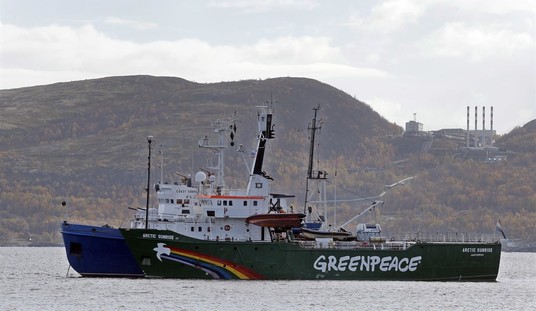The fall of Mariupol after months of valiant defense will no doubt be a bitter pill to swallow for the Ukrainians. Tens of thousands of people died in the defense of the key southern city, and its fall allows Russia to link up the Donbas and Crimea — for a while, anyway. In the end, however, relief never made it, and as Volodymyr Zelensky declared overnight, it was time to save what little was left of their Mariupol defense forces:
Ukrainian fighters have ended their weeks-long defense of a besieged steel plant in the strategic port city of Mariupol, as hundreds of combatants — dozens of them seriously wounded — were evacuated from the complex Monday.
“Ukraine needs Ukrainian heroes alive,” President Volodymyr Zelensky said in his nightly address, as the delicate operation continued. “We hope that we will be able to save the lives of our guys. Among them are the seriously wounded. They are being provided with medical aid.”
Mariupol’s Azovstal Iron and Steel Works and its network of underground tunnels have for weeks served as a shelter and final foothold for some 1,000 Ukrainian fighters, including many from the Azov Regiment, one of Ukraine’s most skilled — and controversial — military units.
Mariupol officials said in mid-April that as many as 1,000 civilians were also hiding in the subterranean network. They were trapped for weeks amid an intense Russian assault, before all women, children and elderly people were evacuated earlier this month. Those who made it to safety described the brutality of the long siege in the cold and fetid bunkers, where they lived without sunlight and with food and water supplies dwindling.
Ukrainians had hoped to mount a counteroffensive that could relieve Mariupol, both to rescue its forces and to block the Russian lines of communication to Crimea. Unfortunately, early Russian advances in the southern part of Ukraine proved too much to overcome. The fall of Mariupol at this point may only relieve a small amount of pressure, given that Mariupol’s defenders had collapsed weeks ago into the small pocket at the Azovstal steel plant and couldn’t directly impact Russian logistics anyway, but the distraction they provided likely tied up some combat troops that Russia could have used elsewhere. That will end with the surrender today.
However, it’s not clear that it improves Russia’s strategic or tactical position much either. They destroyed Mariupol to finally seize it, and its port will now be almost useless. Russian ships no longer venture close to Ukrainian shores for fear of accurate missile attacks that have sunk or damaged a series of Russian naval ships, including the Moskva. The link to Crimea would be helpful, except that Ukrainian counteroffensives in Kharkiv and in the Donbas now threaten to turn the Russian flank and threaten their lines of communication from Russia itself. The Institute for the Study of War notes the strategic cost from their failure at Kharkiv, echoing the point I made yesterday about a new threat to Belgorod:
The Russian grouping around Kharkiv City is notably trying to hold the border and prevent Ukrainian troops from advancing further north. This activity is different from previous Russian withdrawals from around Kyiv, Chernihiv, and Sumy earlier in the war when the Russians pulled completely back to Russian territory. Russian troops may seek to retain positions in Ukraine and continue artillery strikes on Ukrainian positions in order to prevent Ukrainian forces from getting into tube or rocket-artillery range of the outskirts of Belgorod, a major city in Russia and a key hub of the Russian military effort. The Russians might alternatively hope to conduct a counter-counter-offensive to push back south toward Kharkiv, although such an effort is highly unlikely to succeed.
Ukrainian forces advanced to the border yesterday in the Kharkiv sector. ISW reports that the connection took place to the north of Kharkiv, but it’s still not clear if Ukraine flanked Russian units or split them to get to that position. If they split the Russians, then one northern segment is cut off and at risk for annihilation — unless they retreat back to Russia and adopt a defensive posture to protect Belgorod.
Of more interest is what ISW sees in the south, however. The fall of Mariupol will only have significant value if Russia can hold Donbas, but it appears that their political and military situations are eroding:
Frictions between Russian occupation administrations and pro-Russian collaborators is growing in occupied areas of Ukraine. The Zaporizhia Oblast Military Administration reported that Russian forces are having serious conflicts with collaborators due to interpersonal power conflicts.[4] A well-known collaborator in Zaporizhia accused the Russian-installed governor of the area of stealing his 10,000 ruble compensation. Advisor to the Mayor of Mariupol Petro Andryshchenko additionally claimed that relatives of those mobilized into the forces of the Donetsk People’s Republic (DNR) are holding a mass protest against mobilization in Donetsk City. While ISW cannot independently verify these claims, such discontent amongst occupation elements suggests a general lack of planning by Russian authorities in occupied areas, now compounded by increasingly evident Russian losses.
Lack of Russian planning has plagued the entire “special military operation” in Ukraine. It’s been clear since the first week of fighting, and especially after losing the airport at Hostomel, that Russia never bothered to prepare at all for the invasion, not even with proper food provisions. They expected Ukraine to surrender at the sound of the first artillery blasts. Instead, they are now fighting a full-on war and have no idea how to conduct themselves against even a numerically inferior force. Putin and his team got flabby and corrupt by spending the last twenty years fighting asymmetrical conflicts against partisan militias and overcoming them through sheer brutality, but that doesn’t work against a well-organized military, especially one fighting for its own land.
Putin got a momentary breather in Mariupol, but it already looks like he can’t leverage it. In a month, give or take a week, Putin might have to fight another battle to keep it at the rate Russia is going in Donbas.








Join the conversation as a VIP Member